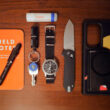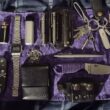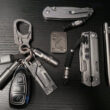If you EDC a knife, you know how important it is to keep it sharp. A dull knife will make it hard to cut through rough material. And if it worsens, you can injure yourself when the dull blade slips instead of slices. Buying a quality knife made of good steel means the cutting edge will have optimum sharpness out of the box, but eventually, all blades get dull. Even costly grail knives made of super premium steel must be sharpened after a while.
One of the best ways to handle that is with a set of whetstones, also known as sharpening stones. These are flat sheets of abrasive material that you can slide and rub a knife edge against to rebuild and refine its sharpness. Whetstones made of literal stones and rocks were some of the first and most essential tools used to keep sharp implements going, and they still have a place in EDC today.
Modern whetstones, however, now feature precise amounts of abrasion, defined as grit, based on the smoothness and roughness of the stone. Synthetic options exist, too. For example, the best knife sharpeners are made of ceramic or metal alloys and sharpening stones that feature ultra-hard diamond surfaces.
This guide will introduce you to our favorite sharpening stones and explain why these top picks will help you keep your everyday carry knives in tip-top shape.
Our Favorites
The Best Overall Knife Sharpening Stone: King PB-05 Combination Whetstone [Buy]
The Best Knife Sharpening Stone on a Budget: Winco SS-1211 Silicon Whetstone [Buy]
The Best Pocket Knife Sharpening Stone: Diamond Machining Technology Diafold [Buy]
The Best Diamond Knife Sharpening Stone: Diamond Machining Technology DuoSharp Plus [Buy]
The Most Comprehensive Knife Sharpening Stone: Work Sharp Benchstone [Buy]
King PB-05 Combination Whetstone |
Winco SS-1211 Silicon Whetstone |
Diamond Machining Technology Diafold |
Diamond Machining Technology DuoSharp Plus |
Work Sharp Benchstone |
 |
 |
 |
 |
 |
| $ |
$ |
$ |
$$ |
$ |
| Grits: 220/800 | Grits: 150/280 | Grits: 600/1200 | Grits: 600/1200 | Grits: 400/800 |
| Model: PB-05 | Model: SS-1211 | Model: FWEF | Model: WM8EF-WB | Model: WSBCHBSS |
| Key Features: Two-sided stone | Key Features: Uses oil instead of water | Key Features: Butterfly-style design | Key Features: Dual diamond surface | Key Features: Angle guides |
| Buy Now | Buy Now | Buy Now | Buy Now |
- 1 – The Best Overall Knife Sharpening Stone: King PB-05 Combination Whetstone
- 2 – The Best Knife Sharpening Stone on a Budget: Winco SS-1211 Silicon Whetstone
- 3 – The Best Pocket Knife Sharpening Stone: Diamond Machining Technology Diafold
- 4 – The Best Diamond Knife Sharpening Stone: Diamond Machining Technology DuoSharp Plus
- 5 – The Most Comprehensive Knife Sharpening Stone: Work Sharp Benchstone

The Best Overall Knife Sharpening Stone: King PB-05 Combination Whetstone

The Best Knife Sharpening Stone on a Budget: Winco SS-1211 Silicon Whetstone

The Best Pocket Knife Sharpening Stone: Diamond Machining Technology Diafold

The Best Diamond Knife Sharpening Stone: Diamond Machining Technology DuoSharp Plus

The Most Comprehensive Knife Sharpening Stone: Work Sharp Benchstone
What is a Knife Sharpening Stone?
A knife sharpening stone is a flat but abrasive surface used to sharpen and refine a knife’s edge. EDC knives get used often, just like kitchen knives, and that’s where a knife sharpening stone comes in handy. All you need to do is side the entire length of the blade across the whetstone at the same angle as the original edge. This takes away material and hones a minute amount of steel in the blade, recreating a sharp edge like the knife did when it was brand new from the factory.
Oil Stones
Oil is used with some kinds of sharpening stones to help prevent excessive wear. This also makes using the blade on the stone easier without catching on the rough material. Oil stones tend to be cheap, but there are better options for high-end knives, and the available grits are limited because they tend to be made of silicon carbide or aluminum oxide.
Diamond Sharpening Stones
Diamonds are extremely hard, which means a sharpening stone made of diamonds, even a thin and tiny layer, makes short work of the softer stainless steel on blades. Using a diamond sharpening stone can lead to less time spent in front of a stone because it gets the job done quicker, giving you a fine edge. Diamond stones tend to be substantially more expensive than other sharpening stones, so keep that in mind, especially if this is your first time using them.
Water Stones
Water stones are the most traditional form of whetstones, ranging from literal stones taken from quarries that have been worked into a desirable flat shape for sharpening knives to synthetic stones that do the same thing. The difference is that these sharpening stones need to be soaked in water and kept wet to keep them going instead of oil.
Arkansas Stones
As their name implies, these are natural stones from a specific mountain range in Arkansas in the United States. These stones feature sharp pebble premium whetstone silicon quartz material, making them great for sharpening knives. Their grits can be determined based on the color and their feel in hand. Arkansas stones can be more fragile and brittle compared to diamonds and synthetic sharpening stones, and sometimes similar stones that are not Arkansas stones are labeled as such online. But if you get the real deal, you have a tried and tested sharpening stone that you can rely on.
What To Look For in a Knife Sharpening Stone?
A good sharpening stone has the following features:
- The right amount of grit to either repair, resharpen, or hone your knife to a mirror polish. Lower grit means it’s a coarse stone, and higher numbers indicate it is finer grit.
- A non-slip base like a bamboo base or a rubberized bottom that prevents the stone from moving during use and which is easy to clean up.
- Sufficient length for the knife blades you’re trying to sharpen. If you have a tiny stone, you can still sharpen large knives, but it will take more time and be more challenging than using a correctly sized whetstone for the task at hand.
- The material you want to use as it dictates whether you have to soak the stone in water or oil (or keep it dry). Different kinds of sharpening stone materials must be maintained in their own way, like with a flattening stone.
Who Needs a Knife Sharpener?
Everyone who carries or uses a knife eventually needs a sharpener, as all blades eventually get dull, even if they are high-end pricey grail knives made of super-premium stainless steel. Even if you’re just a home cook with a high-quality Japanese knife set, having a good sharpening process will give you a razor-sharp edge every time.
FAQs
What is the best stone to sharpen knives?
Many types of sharpening stones between 800 and 1200 grit can give you a sharp blade for most everyday carry and kitchen use.
What is the best brand of sharpening stone?
There are many brands of sharpening stones with various grit levels, but it is best to pick reputable ones because you will rely on these tools to keep your blades working in the future.
What do professionals use to sharpen their knives?
Whetstones and strops are a common choice in the professional world, especially for users of high-end knives and kitchen cutlery made in Japan because they let you maintain the original factory edge. Cheaper pull-through knife sharpeners and electric knife sharpeners might get the job done in a way, but they are made for many types of knives with standard grinds, and they can ruin a quality knife if used haphazardly.
What sharpening stones do chefs use?
Chefs often use sharpening stones and sharpening systems to keep their tools in good shape before work. They also use honing steels for quick touch-ups to bring knives back into line throughout service.
How We Picked
As avid knife users, we have used many whetstones (and other sharpening methods) in our quest to keep our gear working day in and day out. In addition, decades of experience and deep connections in the everyday carry industry give us a unique viewpoint on the market to inform our product recommendations. We have the depth of information for thousands of products that have come before and an extensive eye on the market to see what’s new and trending for each piece of gear. The result is a buying guide that we feel is informative and useful for EDCers of every trade, industry, and budget.
What is Everyday Carry?
Everyday Carry is both the concept of what people carry in their pockets and the process of picking out gear that thoughtfully considers what one wants or needs in their daily lives. It encompasses everything from style to preparedness to utility, meaning an entire industry full of valuable tools and essentials to choose from.
Why You Should Trust Us
Our team has decades of combined experience in all aspects of everyday men’s essentials, from wallets to pens to bags and everything in between, and we know where to find great gear ideas that you may not come across at your local stores or when shopping online. Our expertise with the industry and familiarity in design, materials, and usability help you make more informed choices when it comes to picking up your next piece of gear.









